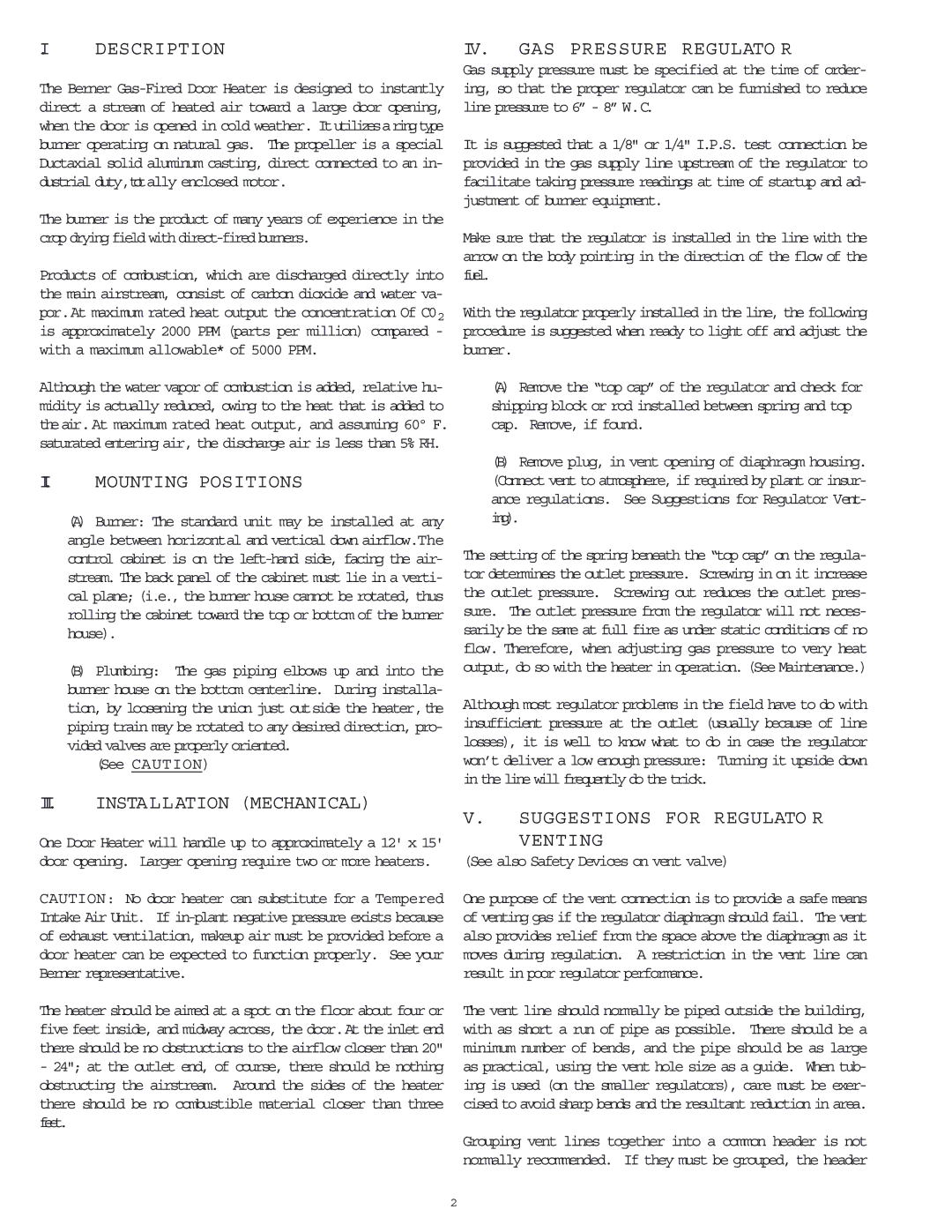.I | DESCRIPTION | IV. GAS PRESSURE REGULATO R |
The Berner
The burner is the product of many years of experience in the crop drying field with
Products of combustion, which are discharged directly into the main airstream, consist of carbon dioxide and water va- por.At maximum rated heat output the concentration Of C02 is approximately 2000 PPM (parts per million) compared - with a maximum allowable* of 5000 PPM.
Although the water vapor of combustion is added, relative hu- midity is actually reduced, owing to the heat that is added to theair.At maximum rated heat output, and assuming 60º F. saturated entering air, the discharge air is less than 5% RH.
I. MOUNTING POSITIONS
(A)Burner: The standard unit may be installed at any angle between horizontal and vertical down airflow.The control cabinet is on the
(B)Plumbing: The gas piping elbows up and into the burner house on the bottom centerline. During installa- tion, by loosening the union just outside the heater,the piping train may be rotated to any desired direction, pro- vided valves are properly oriented.
(See CAUTION)
Gas supply pressure must be specified at the time of order- ing, so that the proper regulator can be furnished to reduce line pressure to 6” - 8” W.C.
It is suggested that a 1/8" or 1/4" I.P.S. test connection be provided in the gas supply line upstream of the regulator to facilitate taking pressure readings at time of startup and ad- justment of burner equipment.
Make sure that the regulator is installed in the line with the arrow on the body pointing in the direction of the flow of the fuel.
With the regulator properly installed in the line, the following procedure is suggested when ready to light off and adjust the burner.
(A)Remove the “top cap” of the regulator and check for shipping block or rod installed between spring and top cap. Remove, if found.
(B)Remove plug, in vent opening of diaphragm housing. (Connect vent to atmosphere, if required by plant or insur- ance regulations. See Suggestions for Regulator Vent- ing).
The setting of the spring beneath the “top cap” on the regula- tor determines the outlet pressure. Screwing in on it increase the outlet pressure. Screwing out reduces the outlet pres- sure. The outlet pressure from the regulator will not neces- sarily be the same at full fire as under static conditions of no flow. Therefore, when adjusting gas pressure to very heat output, do so with the heater in operation. (See Maintenance.)
Although most regulator problems in the field have to do with insufficient pressure at the outlet (usually because of line losses), it is well to know what to do in case the regulator won’t deliver a low enough pressure: Turning it upside down in the line will frequently do the trick.
I. INSTALLATION (MECHANICAL)
One Door Heater will handle up to approximately a 12' x 15' door opening. Larger opening require two or more heaters.
CAUTION: No door heater can substitute for a Tempered Intake Air Unit. If
The heater should be aimed at a spot on the floor about four or five feet inside, and midway across, the door.At the inlet end there should be no obstructions to the airflow closer than 20"
-24"; at the outlet end, of course, there should be nothing obstructing the airstream. Around the sides of the heater there should be no combustible material closer than three feet.
V.SUGGESTIONS FOR REGULATO R
VENTING
(See also Safety Devices on vent valve)
One purpose of the vent connection is to provide a safe means of venting gas if the regulator diaphragm should fail. The vent also provides relief from the space above the diaphragm as it moves during regulation. A restriction in the vent line can result in poor regulator performance.
The vent line should normally be piped outside the building, with as short a run of pipe as possible. There should be a minimum number of bends, and the pipe should be as large as practical, using the vent hole size as a guide. When tub- ing is used (on the smaller regulators), care must be exer- cised to avoid sharp bends and the resultant reduction in area.
Grouping vent lines together into a common header is not normally recommended. If they must be grouped, the header
2
